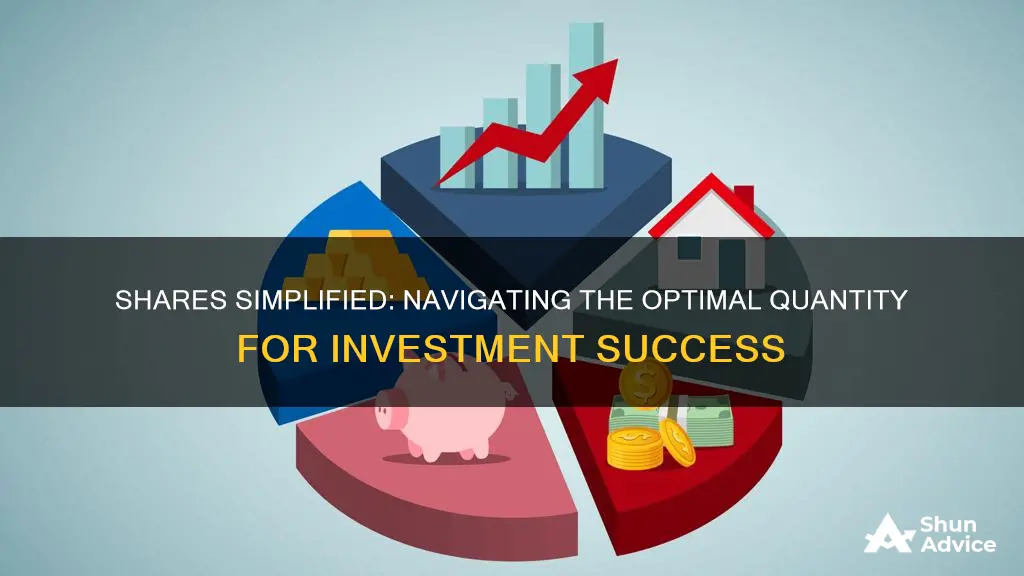
There are several factors to consider when deciding how many shares to buy when investing. Firstly, you should calculate how many shares you can buy by dividing your investment capital by the stock's price, allowing for fractional purchases if available. Diversifying your investments across multiple stocks can help to reduce risk and maximise potential returns.
It's important to note that there is no one-size-fits-all answer to this question as it depends on various factors such as your investment goals, risk tolerance, and the amount of money you have available to invest. However, financial advisors generally recommend holding between 20 and 30 stocks in your portfolio to achieve meaningful diversification and reduce risk.
Additionally, when buying stocks, you can use different types of orders such as market orders and limit orders. A market order is best for buy-and-hold investors as it executes the trade immediately at the best available current market price. On the other hand, a limit order gives you more control over the price at which your trade is executed, allowing you to set a specific price or better.
| Characteristics | Values |
|---|---|
| Number of shares | This depends on your available capital, your diversification strategy, and whether your broker allows fractional share investing. |
| Diversification | Diversifying your portfolio is recommended to reduce risk and maximise potential returns. |
| Broker fees | Some brokers charge fees for fractional share transactions. |
What You'll Learn
- Diversification: Spread investments across multiple stocks to reduce risk and maximise returns
- Fractional shares: Consider buying less than a full share to access stocks with a high share price
- Broker fees: Account for brokerage fees and commissions when deciding how many shares to buy
- Risk tolerance: Assess your risk comfort level and investment goals when determining how many shares to buy
- Research: Conduct thorough research on the company and its performance before deciding how many shares to buy

Diversification: Spread investments across multiple stocks to reduce risk and maximise returns
Diversification is a key investment strategy, and it's important to spread your investments across multiple stocks to reduce risk and maximise returns.
The average diversified portfolio holds between 20 and 30 stocks, with some experts recommending a minimum of 10 to 15 stocks for beginners. Diversification ensures that no single company or industry has too much influence over the value of your holdings, reducing the risk of a significant drop in your portfolio's value.
For example, if you hold 20 stocks in your portfolio, each representing 5% of your portfolio, a 50% decline in a single stock will only translate to a 2.5% drop in your portfolio's value.
However, owning too many stocks can be impractical and may result in high trading fees and an administrative burden. It's important to thoroughly understand why you've invested in each stock in your portfolio.
To achieve meaningful diversification, consider investing in different types of stocks, such as growth stocks and dividend stocks, and incorporate a mix of large, medium, and small-capitalisation stocks. Additionally, spread your investments across several different industries to minimise the impact of a downturn in any one sector.
Fractional shares, offered by many online brokers, can also help with diversification, as they allow you to invest in high-priced stocks with a smaller amount of capital.
Remember, diversification is just one aspect of a successful investment strategy. It's also crucial to consider your risk tolerance, investment goals, and the amount of time and money you can dedicate to researching and managing your portfolio.
Amer Sports: Who Invests?
You may want to see also

Fractional shares: Consider buying less than a full share to access stocks with a high share price
Fractional shares allow investors to buy a portion of a stock, making it easier to diversify even with small amounts of money. Fractional shares let you buy stock based on a dollar amount rather than the number of shares. For example, if you invested $50 in a stock but a whole share cost $100, you'd own half a share.
Fractional shares can help you build the portfolio you want but couldn’t previously afford. For example, if a stock trades for $3,000 per share, you’d need at least $3,000 just to add it to your portfolio. Want to buy more than one share? You’ll have to purchase in increments of $3,000 ($6,000 for two shares, $9,000 for three shares, and so on). If you don’t have that much set aside, you’ll need to find another investment. The most expensive stocks can make it difficult to diversify your portfolio if you're on a budget.
But this isn’t the case with fractional shares. Fractional trading lets you buy the amount of stock you can afford, whether that’s $5, $50, $500, or $5,000. For instance, if you want to invest in a company but its stock price is higher than what you want to pay, you can buy a fractional share, which is a "slice" of stock that represents a partial share, for as little as $5.
Fractional shares are also beneficial for investors who want to effectively diversify their funds. Investing lower dollar amounts and being able to diversify used to only be available in mutual funds. However, now that many brokerages offer fractional shares, investors can choose which companies they want to invest in, and can trade the fractional shares at any time. Having the option to only invest in a fractional share allows investors to choose several stocks rather than putting all of their money into just one company in order to purchase a certain amount of whole shares.
Fractional shares are a relatively new development in investing. Only a few years ago, it was almost impossible to buy less than single shares of stocks and ETFs. Mutual funds have long supported fractional share investing, but until recently, you could only own fractions of shares in a few limited ways, such as stock splits or reverse stock splits, dividend reinvestment plans, and mergers and acquisitions.
Many online brokerage platforms sell fractional shares, including Fidelity, Charles Schwab, and Robinhood. Investing apps such as Stash, Cash App Investing, and SoFi Invest also offer fractional shares. A few robo-advisors, like Acorns and Betterment, purchase fractional shares for your portfolio. Depending on the brokerage, you might need to buy at least $1 or up to $5 worth of fractional stock.
Before purchasing fractional shares, make sure you understand your brokerage’s fractional share policies and fully understand the pros and cons of buying portions of shares.
Retirement Planning: Strategies for Long-Term Financial Freedom
You may want to see also

Broker fees: Account for brokerage fees and commissions when deciding how many shares to buy
Broker fees are an important consideration when deciding how many shares to buy when investing. These fees can vary from broker to broker and can impact your overall returns and investment experience. Here are some key points to consider:
Types of Broker Fees
Brokerage fees can be broadly categorised into trading fees and non-trading fees.
Trading Fees
Trading fees are charged when you buy or sell stocks, and they can include:
- Commissions: These are usually based on the volume of shares traded or charged as a flat fee per trade. In the US, commissions are typically a flat fee per trade (e.g. $5/trade) or calculated based on the number of shares traded (e.g. $0.005/share). When trading in European markets, the commission is often based on the volume of your trade (e.g. 0.1% of the total volume).
- Spread: This is the difference between the buy and sell price, or the bid and ask price. The wider the spread, the higher the cost.
- Financing Rate: This is a fee charged when you hold a leveraged position (e.g. forex trade or CFD trade) overnight or for an extended period.
- Margin Rate: Trading on margin means borrowing money from your broker to trade. You will be charged interest on the borrowed money.
- Currency Conversion Fee: This fee is incurred when your transaction requires a currency conversion, such as when buying a stock in a different currency or depositing money in a different currency into your brokerage account.
Non-Trading Fees
Non-trading fees are charges not directly related to trading activities, such as:
- Account Fees: Some brokers charge monthly, quarterly, or annual fees to maintain your account. These fees can range from $50 to $200 or more per year.
- Deposit/Withdrawal Fees: Fees may be charged when depositing or withdrawing funds from your brokerage account.
- Inactivity Fees: Some brokers charge a fee if your account remains inactive for a certain period.
- Research and Data Subscriptions: Some brokers offer premium research and data services for an additional fee.
- Trading Platform Fees: While most brokers offer a free trading platform, some may charge a monthly fee for access to their platform.
- Paper Statement Fees: You may be charged a small fee (typically $1 to $2) for receiving paper statements instead of opting for electronic statements.
- Account Closing or Transfer Fees: Most brokers charge a fee if you close your account or transfer it to another brokerage.
Impact of Broker Fees on Share Purchases
Broker fees can significantly impact the number of shares you can purchase and your overall returns. Here are some key considerations:
- Cost per Share: When calculating the cost of purchasing a certain number of shares, don't forget to factor in the brokerage fees. For example, if you buy 100 shares at $10 per share and incur a $20 trading fee, your average cost per share is $10.20.
- Break-Even Point: The broker fees will affect how much the share price needs to increase for you to break even on your investment. In the previous example, the share price would need to increase by $0.20 for you to break even, whereas a single share purchase with the same trading fee would require a 200% increase in the share price to break even.
- Diversification: Broker fees can also influence your diversification strategy. If you are investing smaller amounts, consider choosing a broker with low fees or zero-commission trading to maximise your purchasing power and allow for diversification across multiple stocks.
- Fractional Shares: Some brokers offer the option to buy fractional shares, which can provide access to stocks with high share prices. However, some brokers may charge additional fees for this service, so be sure to check.
- Commission-Free Trading: Many brokers now offer commission-free trading for stocks, ETFs, and options. This can be advantageous for buying smaller volumes of shares, as you avoid potential minimum fees.
- Fee Structure: When deciding on a broker, carefully review their fee structure for the types of trades and investments you plan to make. Consider the overall impact of their fees on your investment strategy and returns.
Mortgage Freedom or Investment: The $100,000 Dilemma
You may want to see also

Risk tolerance: Assess your risk comfort level and investment goals when determining how many shares to buy
Risk tolerance is a crucial aspect of investing, influencing the types and amounts of investments individuals choose to make. It refers to the degree of risk an investor is willing to take on, given the potential for gains or losses in the value of their investments. When determining how many shares to buy, assessing your risk comfort level and investment goals is essential. Here are some factors to consider:
Investment Goals
Understanding your investment goals is the first step in determining your risk tolerance. Ask yourself why you are investing. Common goals include saving for a child's education, achieving financial independence, or retirement planning. Knowing your goals helps you assess your timeframe and the amount of money needed, which in turn influences your risk appetite.
Time Horizon
Your investment goals are closely tied to your time horizon, which is the period over which you plan to invest. Generally, a longer time horizon, such as saving for retirement, allows for a more aggressive investment strategy with a higher risk tolerance. This is because you have more time to recover from potential downturns in the market. Conversely, a shorter time horizon, such as saving for a house down payment, may require a more conservative approach with a lower risk tolerance to avoid significant losses before achieving your goal.
Comfort with Short-Term Losses
Consider how comfortable you are with potential short-term losses. Investments, especially stocks, can fluctuate in value. While a decline in share value doesn't realise a loss until you sell, it's important to assess your tolerance for short-term volatility. If you have a longer time horizon, you can hold on to investments with the expectation that they will recover and increase in value over time.
Non-Invested Savings
Having a substantial amount of savings set aside in liquid accounts is important, regardless of your risk tolerance. This provides financial security in case of emergencies and unexpected expenses. However, if you find yourself keeping a large portion of your savings in cash due to anxiety about investing, it may indicate a lower risk tolerance.
Tracking Behaviour
Consider how frequently you plan to track your investments. Will you be monitoring them daily, weekly, or only semi-regularly? If the idea of market fluctuations makes you anxious, a more diversified portfolio focused on long-term goals can help ease concerns about short-term losses. On the other hand, if market movements excite you and prompt you to seek new investment opportunities, you may be more comfortable with a higher level of risk.
Risk Tolerance Assessments
Online risk tolerance questionnaires and surveys can be useful tools to help you understand your risk comfort level. These assessments consider various factors, including your age, income, investment goals, and financial situation, to provide an estimate of your risk tolerance. While they offer a starting point, remember that different websites may have biases towards certain financial products or services.
In conclusion, assessing your risk comfort level involves evaluating your investment goals, time horizon, and behavioural tendencies. By understanding your risk tolerance, you can make more informed decisions about how many shares to buy and construct a portfolio that aligns with your financial objectives and tolerance for volatility.
US Retirement Investments: Exploring the Impact for Non-Citizens
You may want to see also

Research: Conduct thorough research on the company and its performance before deciding how many shares to buy
Researching a company thoroughly before buying its shares is a crucial step in making informed investment decisions. Here are some essential steps to conduct thorough research:
Understand the Company's Business and Revenue Model:
Read about the company's business activities and how it generates revenue. This information is usually available on the company's website, investor relations section, or news updates. Understanding the company's business model will help you assess if it aligns with your investment goals and values.
Review Financial Reports and Key Metrics:
Analyze the company's financial reports, such as Form 10-K (annual report) and Form 10-Q (quarterly updates). Pay close attention to key financial metrics like revenue, net income, earnings per share (EPS), price-to-earnings ratio (P/E ratio), return on equity (ROE), and market capitalization. These metrics provide insights into the company's financial health and performance.
Study Price Charts and Trends:
Utilize price charts to identify medium to long-term trends in the company's share price history. This analysis can help confirm or challenge your assumptions about the direction of the share price. It takes time to master chart analysis, but it can provide valuable insights into the company's performance over time.
Monitor the Stock and Set Up a Watchlist:
Keep a close eye on the stocks you're interested in by adding them to a watchlist. This helps you easily access share price movements, charts, news, and other critical details. Monitoring stocks over time can give you a better sense of their performance and potential entry points for investing.
Evaluate the Broader Landscape:
Look beyond the company's financials and consider the industry it operates in. Assess the company's competitive advantage, the ease of entry for competitors, potential economic impacts, product substitutability, and the power dynamics between the company, customers, and suppliers. Understanding the broader landscape can help identify risks and opportunities.
Seek Expert Commentary and Analysis:
Leverage the insights provided by market analysts and economists. Many trading platforms and financial websites offer expert commentary and in-depth analysis on specific stocks. This can provide valuable perspectives and help you make more informed decisions.
Remember, investing in stocks carries risks, and it's essential to conduct thorough research before making any investment decisions. The steps outlined above can help you make more informed choices about how many shares to buy when investing.
GICs: Safe, Secure, and Simple
You may want to see also
Frequently asked questions
Divide your investment capital by the stock's price, allowing for fractional purchases if available.
The smallest number of shares an investor can purchase is one, but investors can also buy fractional shares, with as little as $1 applied to a stock buy order.
The average diversified portfolio holds between 20 and 30 stocks. Diversifying your portfolio in the stock market is a good idea for investors because it decreases risk by ensuring that no single company has too much influence over the value of your holdings.
This depends on the dollar amount you want to invest. If the share price is $50 and you have $500, you could buy 10 shares. However, if your brokerage doesn't allow fractional trading, you may have to round down. If the stock price is $51 and you have $500, you can only buy nine shares, as 10 shares would cost $510.







